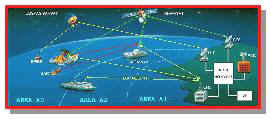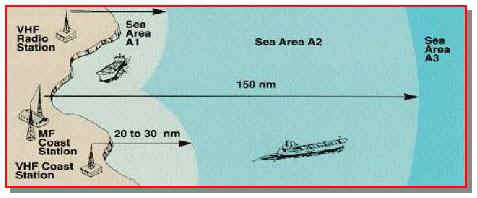
The GMDSS regulations (chapter IV of the International SOLAS Convention), require that every GMDSS equipped ship shall be capable of;
The GMDSS applies to vessels subject to the SOLAS Convention - that is:
Commercial vessels of 300 Gross Registered Tons (GRT) and above, engaged on international voyages.
The GMDSS became mandatory for such vessels as at February 1, 1999.
Commercial vessels under 300 GRT, or those above 300 GRT engaged on domestic voyages only are subject to the requirements of their Flag State. Some Flag States have incorporated GMDSS requirements into their domestic marine radio legislation - however many have not.
The major difference between the GMDSS and its predecessor systems is that the radio communications equipment to be fitted to a GMDSS ship is determined by the ship's area of operation, rather than by its size.
Because the various radio systems used in the GMDSS have different limitations with regards to range and services provided, the new system divides the world's oceans into 4 areas:

The GMDSS utilises both satellite and terrestrial (ie: conventional) radio systems.
Sea Area A1 requires short range radio services - VHF is used to provide voice and automated distress alerting via Digital Selective Calling (DSC).
Sea Area A2 requires medium range services - Medium Frequencies (MF - 2 MHz) are used for voice and DSC.
Sea Areas A3 and A4 require long range alerting - High Frequencies (HF - 3 to 30 MHz) are used for voice, DSC and Narrow Band Direct Printing (NBDP - aka radio telex).
Equipment requirements vary according to the area the ship is trading to or through. Accordingly, it is quite possible that a small 300 ton cargo vessel may carry the same amount of communications equipment as a 300,000 ton oil tanker, if they are both operating in the same area....this is a marked change from the pre-GMDSS systems.
This is illustrated in the diagram below:

As discussed above, equipment fit requirements vary according to the Sea Area(s) a vessel operates in or through.
It should be noted that the requirements are cumulative in nature - ie: an A4 vessel is also equipped, by definition, with equipment for A1, A2 and A3 Sea Areas.
In areas where A1 Services are provided, coastal vessels are only required to fit VHF equipment, provided of course that they remain within the declared Sea Area - normally within 20 to 30 nautical miles of the coast.
Vessels that trade further from land are required to carry MF equipment, in addition to VHF.
Ocean going vessels fit VHF, MF, HF and Inmarsat equipment. The process is depicted below:
Sea areas

However, it should be noted that the above examples assume a linear transition from A1 to A4 sea areas - in many areas of the world, (such as Australia) A3 areas extend right up to the coast line. GMDSS vessels operating in or through those areas are required to fit A3 equipment.
Each of the countries contracting to the SOLAS Convention (basically, all of the world's major shipping nations) are required to enforce the equipping of vessels sailing under their flag with GMDSS and also provide suitable GMDSS shore-based infrastructure.
The shore based infrastructure (ie: Coast Radio Stations) may be provided in conjunction with neighbouring states.